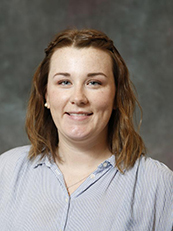Public Health Buckeyes: Molly Mills
Environmental public health PhD student explores antibiotic resistance in Ohio, Brazil

Each month, the College of Public Health shines a spotlight on one of its students. For February, meet Molly Mills, a fourth-year doctoral student in the Environmental Sciences Graduate Program with a specialization in environmental public health. Through her work with Professor of Environmental Health Sciences Jiyoung Lee, Mills is helping piece together clues to mitigate the global antibiotic resistance crisis.
Can you tell us a bit about you?

I grew up in Cleveland. I always spent a lot of time outdoors, but also loved reading and writing.
I went to undergrad at Mercyhurst University in Erie, Pennsylvania, where I pursued a degree in biology with a minor in French. There, I fell in love with the intersection of the environment and human health, as well as science education.
Why did you decide to pursue public health at Ohio State?
I was drawn to Ohio State because of its approach to public health, which is one that’s inclusive of many disciplines. This has led me to work and interact with people from various backgrounds, which I believe leads to creative research and solutions to public health problems.
Can you tell us about your research?
The theme of my research is environmental antibiotic resistance, specifically the interaction between antibiotic resistance genes and microbial communities. Most antibiotic resistance research is focused on clinical settings — for example, most people have heard of issues like Methicillin-resistant Staphylococcus aureus (MRSA) in hospitals. However, antibiotic resistance is an ancient process that’s existed in environmental bacteria long before the creation of antibiotics.
There are two major projects I’ve been involved in during my time here. The first is centered around waterways in Ohio, where we collect samples of things like fish, sediment and water. We then measure the abundance of antibiotic resistance genes in these samples and compare their microbial communities. This project is primarily interested in human impacts on the natural landscape, such as wastewater from urban wastewater treatment plants.
The second project is centered on human health in Brazil. We’re collecting fecal samples from infants, as well as swabs from surfaces in their homes and samples of their drinking water. This helps us study how the gut microbiome relates to indoor household environment and antibiotic resistance genes in early life.
What are your goals after receiving your PhD?
I would like to become a professor at a small- to mid-sized university where I can teach undergraduate courses and continue my research.
What excites you the most about your research?
The most exciting thing about studying anything related to the microbiome is how new the field is, and how it is constantly evolving. There are always new methods being developed and findings that can completely shift the way you are thinking about a topic.
What advice would you give to students considering pursuing a doctorate?
Remember that progress isn't linear. A doctoral degree takes a long time to complete, and there is not a set timeline, so you’re not always going to feel like you are making as much progress as you want. Keep in mind where you started and how much you've learned and grown since your first day.
What do you hope for the future of public health?
I hope there will continue to be progress in science and health communication. Increasing science literacy is something we can definitely work on in this country, which is only possible through clear, inclusive and unbiased science communication.
About The Ohio State University College of Public Health
The Ohio State University College of Public Health is a leader in educating students, creating new knowledge through research, and improving the livelihoods and well-being of people in Ohio and beyond. The College's divisions include biostatistics, environmental health sciences, epidemiology, health behavior and health promotion, and health services management and policy. It is ranked 22nd among all colleges and programs of public health in the nation, and first in Ohio, by U.S. News and World Report. Its specialty programs are also considered among the best in the country. The MHA program is ranked 5th and the health policy and management specialty is ranked 21st.